








Happy New Year! I’m sure that folks have made those New Year resolutions all in the march to better ourselves and our communities. 2024 had its ups and downs but as a group, we managed to have fantastic lectures, a nursery that hums along and provides loads of plants for the community to purchase, and so many other projects. Unfortunately, we also had to say goodbye to some dear friends in 2024. However, we have an entire new class of eager volunteers who will be completing their internship portion of their training.
Let’s make one of our resolutions to encourage these new volunteers and show them just how much our group accomplishes when we put our collective minds to it. Let’s also resolve to do at least one thing this year that is out of our comfort zone. That might mean traveling to the opposite end of the county for a membership meeting, or
volunteering for a committee that we never participated in before.
Let’s resolve to come up with new ways to educate the public about all the great things that Florida gardening can provide.
In that vein, we are changing up our newsletter to provide more detailed information about things that our volunteers are involved in. You’ll see the Spotlight portion that will cover that. The Garden Shed portion will be an in-depth article on some aspect of gardening. We’ll keep a few of the old favorites like updated publications and a few other tidbits.
Remember, this newsletter is only as good as the articles and photos that you send to us!
Wishing everyone a very Happy New Year!
Plentiful Plantings
The Editors


New class members at the Environmental Center in Crestview.
Congratulations to all our upcoming Master Gardener Volunteers on completing the classroom portion of their training and diving headfirst into their internship.
A great group of folks and they’ll be an asset to our organization.
Sue Novotny, Allison Finch, Terri Goodhart, Sherie Baxter, Andrew Cooper, Carolyn Coleman, Joe Ohiagu, Whitney Cramer, Susan Hay, Dean Clary, Sheri Murphy, Tracy Mank, Mic Harker, Toni Perez, Jillian Harker, LeRoy Graham, Joanne David, Karen Damrell
Photo by Marg Stewart, 2024
ENH1382 Florida Turfgrass Identification
ENH1138 Crapemyrtle Pruning
AE605 Introduction to Artificial Intelligence in Agriculture
FOR407 The Fire Ecology of Saw Palmetto
EENY-813 Tuliptree Aphid
SL524 Understanding Soil Fertility from an Urban Grower Perspective
SL519 When to Lime Soil and Liming Products Available in Florida
ENH1383 A Beginner’s Guide to Producing and Saving Open-Pollinated Seeds for North Florida Farmers and Gardeners
EENY-443 American Dog Tick
EENY 421 A Sand Fly
EENY-438 Red Bay Psyllid
This edition’s cover is courtesy of Brittany Kain.
The gelatinous orbs you see are slug eggs. Slug and snail eggs look very similar. The key difference is that slug eggs are usually more gelatinous and slightly translucent. Snail eggs tend to be more opaque and slightly harder with a more defined round shape.
Yet another reason to thoroughly wash any produce that you get!
Have an interesting garden photo? Send it along to margaret.stewart@ufl.edu and be sure to give details about the picture.
EENY-418 Slender Twig Ant
EENY 461 Black Soldier Fly
EENY 445 Drone Fly, Rat-Tailed Maggot
EENY488 Redheaded Pine Sawfly
EENY 478 Cecropia Moth
EENY-504 Eastern Black Swallowtail
EENY-58 Zebra Swallowtail
EENY-814 Ornate Tree Hole Mosquito
EENY 451 Mourning Cloak
EENY-110 Great Purple Hairstreak
EENY-505 An Asian Citrus Psyllid Parasitoid
EENY-61 Tiger Swallowtail
ENH1114 Frequently Asked Questions about Landscape Irrigation for Florida-Friendly Landscaping Ordinances





A lot of folks know that we have a plant nursery. Not only does the nursery supply plants for sale at various times of the year but it’s also an educational nursery. We asked the Committee Chairman, Lee Vanderpool about the nursery.
When did you start at the nursery? I began working in the nursery in May 2013. I assumed a leadership role in January 2014 from Jennifer Gillis.
How many plants are in the nursery on average? The nursery is at full capacity just before the spring sale with about 2000 plants. The average number of plants is 1500.
What do volunteers do in the nursery? The Nursery Committee is responsible for plant maintenance such as potting seedlings and rooted cuttings, repotting overgrown plants, grooming and pruning plants, weeding, fertilizing and writing temporary name tags for newly potted plants. After the plants are moved to the growing benches, permanent professional name tags are printed for each plant.
What’s the most unique plant in the nursery? The most unique plant in the
nursery is the musk mallow, Abelmoschus moschatus, a native relative of okra. The simple red flowers of this perennial bloom for one day over a long period of time.
What are the challenges that face the nursery? Winter storage of tender plants is not available and has meant the loss of some desirable plants in the past. There is no dependable watering system which makes placing plants on the growing benches challenging. (Note: thanks to a donation we have a bit more protection for tender plants through this winter season.)
What plants don’t we have that you would love to get? One of the plants we hope to stock next season is blue cardinal flower, Lobelia siphilitica. Another is beach croton, Croton punctatus. We are attempting to acquire more coastal and beach plants.
What do you think the future holds for the nursery with the advent of the new building? Planning has begun for a larger nursery to be located adjacent to the new building. The plan calls for eco-friendly lighting and watering using reclaimed water. Storage facilities will be recycled materials when available. Volunteer labor will play a large part in the construction of the fencing and laying recycled pavers.


What will be the challenges and goals? Money, of course, will play a large part in the new nursery construction. A new greenhouse will be purchased if a donation or
recycled one cannot be located. The main goal is to have an environmentally friendly, large, and efficient nursery.

Working at the potting bench
FUGACIOUS: a formal word that describes something that last only a short time.


Savor the enduring pleasures of life as intensely as the fugacious ones.
rather large fungal body at home in the landscape.


Friends, it’s a jungle out there. Yes, even in our gardens, and sometimes especially in our gardens. We are subject to any number of injuries. Most of us are gardening on our own property or assisting residents who have requested master gardener help. We need to be prepared for injuries including but not limited to surface wounds, allergic reactions, sprains, broken bones, and climate– and weather-related conditions. The first thing to consider is your first aid kit. Here is a suggested list of items to include. You will of course have your own preferences as to brands.
Medical supplies
Scissors
Tweezers
Flashlight and spare batteries
Adhesive tape (medical tape)
A box of latex gloves
Wound care
Antiseptic wipes
Triple antibiotic ointment (e.g. Neosporin)
Gauze pads in multiple sizes, at least two large (8 x 10)
Adhesive bandages in multiple shapes and sizes
2-inch gauze roller bandages
Astringent. Witch hazel is a natural astringent, which helps fight against inflammation, while also cleaning the cut. Witch hazel also helps relieve itch from bites and stings.
Arnica Gel to soothe aching muscles
Sunscreen & Insect repellent
Paper towels
Bottle of distilled water
A splint
Elastic wraps (Ace bandages)
Moleskin (roll or sheets)
Pain relief
Acetaminophen (e.g. Tylenol)
Ibuprofen (e.g. Advil)
Naproxen (e.g. Aleve)
by Karen Harper
Hydrocortisone cream (e.g. Cortizone-10)
Antihistamine (e.g. non-drowsy Claritin)
Burn lotion (aloe vera)
Ice packs
Heat packs
Blanket
Emergency water (distilled)
Written instructions for first aid
Now, how to use all of this to treat injuries? The most common injuries to the gardener are surface wounds. The best defense against surface wounds is always proper apparel.
Wearing work gloves, long sleeves, and long pants will keep you safe from most contact-based injuries. But things happen and here are guidelines for dealing with the various types of surface wounds.
Cuts are the most common injury, occurring when you contact a sharp object. Whether it be your own pruning shears or a rose bush that hates you, cuts happen. Initial treatment: if the wound is bleeding, apply firm pressure until it stops. If bleeding persists longer than a few minutes or is profuse call 911 and keep pressure on the wound to slow the flow. If you can stop or control the blood flow, proceed with treatment. Clean the wound with an antiseptic wipe. Preferably, the wipe has benzalkonium chloride, as those with hydrogen peroxide or alcohol can further damage the skin. Next, apply a triple antibiotic ointment. I keep a tube of Top Care Triple Antibiotic Cream on hand for the humans, dogs, and horses that I’m around daily. You may have your own favorite. Wipe away the excess ointment and apply a bandage. be sure to keep a wide variety of shapes and sizes of bandages on hand.

Burns There are 3 type of burns you may encounter: thermal burns (such as accidentally touching a running motor); chemical burns from some pesticides or fertilizers, and sunburn (discussed in more detail, below). And there are three degrees of burn severity: First-degree burns will have redness and pain on the surface of the skin. Second-degree burns will cause the skin to blister. Third-degree burns cause the skin to char. Get medical attention immediately for third-degree burns or second–or first-degree burns that cover more than 3 inches of skin.
Treatment for 1st and 2nd degree burns: immediately run cool water over the area, especially for a chemical burn, as this will flush away the substance causing the burn. If you don’t have access to running water, use bottle water. Ice water or ice packs are not recommended as they can cause further damage to the skin. If there are blisters, do NOT pop them. Clean the area with antiseptic wipes and then apply aloe vera lotion, and cover loosely with a gauze bandage over it. Over-the-counter pain relievers can reduce pain and swelling of burns.
Blisters Boots or sturdy shoes that fit correctly and good socks will help prevent foot blisters but if they occur, moleskin is the solution to prevent further irritation. First, don’t break the blister. Unbroken skin helps prevent infection. If the blister has already burst, apply antibiotic ointment. Then cut a piece of moleskin into an open ring with the blister in the center. Cover the whole area with a clean gauze pad and secure it in place while the blister heals.
Insect bites and Allergic reactions Again, prevention is best. Wear long sleeves and pants. Spritz on some insect repelllant before you go out and re-apply if you’re out for hours. Always check your legs and body for ticks. Even those
without allergies can have a histamine reaction when encountering certain insects or plants. Keeping an antihistamine in your first aid kit can help with many of these reactions. Benadryl is effective but can cause drowsiness.
Non-drowsy Claritin or its generic versions are effective, minus the drowsiness. Hydrocortisone cream can reduce skin itchiness.
Ticks My person experience with ticks in our area is that they are prevalent during June-August but also again in December, especially if the weather is mild. And their favorite breeding areas seem to be dry brush piles, so keep those cleaned up on your property. If you discover an attached tick on your body:
Remove it. Wearing gloves, grasp the tick with clean tweezers as close to the skin as possible to remove the heat and mouthparts. If some mouthparts remain, do not try to remove them, as your body will expel them naturally. Pull the tick straight out gently and steadily. Do not twist. Save the tick in a container of alcohol, should you need to see a doctor for the bite. Wash hands and clean the bite area with warm water and gentle soap. Apply alcohol to the bite wound to prevent infection. When to see a doctor: See a health care provider immediately if the tick has burrowed into the skin or if the heat, mouthparts, or other tick remains cannot be removed. Otherwise, see a provider if you develop flu-like symptoms including fever, headache, nausea, vomiting, and muscle aches, or a rash within one month after the bite; or the bite area develops a lesion within 30 days. A sign of Lyme disease infection is a “bullseye” rash in which the center becomes clearer as the redness moves outward in a circular pattern; or if there are other signs of infection such as redness, warmth, or inflammation.

Other insect bites and stings. If someone has been stung by a bee or wasp and the sting is visible on the skin, pull it out with your fingers, tweezers, or use the edge of a card to scrape it away. Apply an icepack to the affected area to minimize pain and swelling. Watch for signs of a severe allergic reaction such as difficulty breathing and/or reddened and swollen, itchy skin on the hands, feet or face. If someone has been stung in the mouth or throat, give them an ice cube to suck on or a glass of cold water to drink to help prevent swelling. If swelling does start to develop, call 911 as it could get worse and block their airway.
Fire ants, poisonous spiders, and venomous snakes. Oh my. Yes, I have personal experience with all of these in my own yard, and I’m still alive.
Fire ants. I am someone who has an immediate reaction to fire ant toxin, even if all they do is run across my skin. I’ve learned that the best thing to do is to get to the hose immediately (if there is one) and wash the area thoroughly. This gets the little devils and their toxins off your skin. Then take an antihistamine; then apply hydrocortisone ointment to the bites; then go inside and watch TV the rest of the day because you deserve it.
Poisonous snakes. Learn to identify the poisonous ones! In our Poquito Bayou yard, we have had deadly coral snakes twice. Both occurrences were after major hurricanes went though and the snakes found their way into our yard. There is also the harmless king snake, which has a very similar appearance, with alternating bands of red, yellow, and black but in a different pattern. To help you identify which is which, the old rhyme works: “red touch black, you ’re OK Jack. Red touch yellow, you’re a dead fellow”. I also encountered a pygmy rattler in the woods near our house. It was in the middle of the
trail, so I turned myself and the dog around and made haste the other way. And at the stables on Eglin AFB, I’ve had water moccasins in my barn twice.
Poisonous spiders: Also at our home, we’ve had a black widow spider make an appearance. It was in the bottom of a bucket and we don’t know how it got there. The other was a brown recluse spider that hitched a ride in on some sod pallets. I spotted him in the wheelbarrow that I was using to move the sod around the yard, got a photo and a positive ID and then dispatched it. The sod came from the Milton area. I haven’t seen either of these poisonous spiders here since then, so I don’t believe they’re prevalent here, but the point is USE CAUTION and learn how to ID good from bad, because all these critters found their way here one way or another and they can find you too.
Poison ivy, oak, and sumac: When working around thicker brush, avoid poison ivy and related plants. Avoid touching your face and other exposed areas with the exterior of your clothing. Keep a separate towel or bandana to wipe away sweat. Reactions to these plants will usually be self-limiting and treatment is the same: Apply cortisone cream for the first few days. Apply calamine lotion or creams containing menthol to relieve itchiness; take oral antihistamines; soak the affected area in a cool-water bath that has ½ cup of baking soda or Aveeno in it. Place cool, wet compresses on the affected area for 15 to 30 minutes several times a day.
With all allergic reactions: Signs of an increasingly severe allergic reaction include a rash, itchiness or swelling on a person's hands, feet or face. A person's breathing may also slow down. If you spot these signs, call 911. If the person has a known allergy and an auto-injector,

help them to use it or do it yourself following the guidance on the product
Sprains, fractures, and (heaven forbid) amputations.
Sprains. Prevention!! Pay attention to the ground you ’re walking on and keep your boots or shoes tightly laced for ankle support. If you do twist your ankle or other joint beyond its normal range of motion, you may have a sprain. To treat a sprain, R.I.C.E. is your friend:
R: Rest: Avoid using the sprained limb
I: Apply ice: Use a cold pack or ice bag to reduce swelling
C: Apply compression: Elastic wraps, such as an ACE bandage, will keep your ankle or wrist compressed and still without full immobilization
E: Elevate the injury above your heart when possible
Over-the-counter pain medications, such as Ibuprofen (Advil) or Naproxen (Aleve) are best suited for muscle and ligament injuries.
Broken bone. If the injured limb can’t bear any weight and has bruising or swelling, it may be broken. The limb may also look out of shape or be bent at an unusual angle. Help the person to support the injury using a splint or items of clothing (such as a spare t-shirt) to prevent unnecessary movement. Get the person to the hospital or call 911.
Amputations. Amputations are the most serious of outdoor injuries and can occur in a variety of ways. Contact with a spinning mower blade or brush trimmer can sever fingers, toes, wrists, and other body parts. These injuries can cause life-threatening blood loss and shock. Call for medical attention immediately. If a body part is fully severed, find it and keep it on ice or in a cool location. Treat the amputation victim for shock: Lay the injured person flat and elevate the wound above his or her heart. Apply pressure with a bandage to stop bleeding.
A tourniquet is a tight strap or bandage that can save a person ’s life from blood loss, but YOU MUST KNOW HOW TO APPLY IT
CORRECTLY. If you apply it incorrectly, a tourniquet can cause irreparable damage and prevent the reattachment of the severed limb. DO NOT use it unless pressure and elevation are failing to stop major blood loss.
Dehydration. Signs of dehydration include dry mouth, headaches, dizziness and confusion. Treatment: Drink plenty of fluids. Water is usually sufficient, but oral rehydration solutions or isotonic sports drinks are better as they also replace lost salts.
Sunburn. Prevention, of course. Use a high SPF sunscreen and reapply it as needed. Wear clothing that minimizes your exposed areas. Limit your exposure to sun, especially during the hours of 10 AM – 12 PM, when the sun’ s rays are most direct. If you do get sunburned: Move into the shade. Cool the affected skin by dabbing with cold water. Apply aloe lotion to soothe the area.
Heat exhaustion. Heat exhaustion is a condition caused by dehydration or overexposure to hot temperatures. Signs of heat exhaustion include excess sweating, dizziness, and muscle cramps. If you suspect heat exhaustion, start cooling immediately. Lay the affected person flat in a cool, shady area. Let them sip water, and apply a damp sponge, cloth, or bandage to the head and body. Cool the victim with any means available to you. A garden hose, cold compress, or ice pack can provide lifesaving first aid. If symptoms persist, heat stroke can occur.
Heat Stroke. This is the most serious heat injury. It can happen if the body temperature rises to 104 F (40 C) or higher. Heatstroke is most common in the summer months. Heatstroke needs emergency care. If it's not treated, heatstroke can quickly damage the brain, heart, kidneys and muscles. This damage gets worse the longer treatment is delayed, which increases the risk of serious complications or death. Heat stroke symptoms include High body temperature. A core body temperature of 104 degrees Fahrenheit (40 degrees Celsius) or higher is the main sign of heatstroke. Change in mental state or behavior. Confusion, agitation,

slurred speech, irritability, delirium, seizures and coma can all result from heatstroke. Change in sweating pattern. In heatstroke brought on by hot weather, skin feels hot and dry to the touch. However, in heatstroke brought on by strenuous exercise, sweating may be profuse. Nausea and vomiting. Someone with heatstroke may feel sick to their stomach or vomit. Flushed skin. Skin may turn red as the body temperature increases. Rapid breathing. Breathing may become rapid and shallow. Racing heart rate. Pulse may significantly increase because heat stress places an extreme burden on the heart to help cool the body. Headache. Heatstroke may cause the head to throb. Seek medical attention immediately if heatstroke is suspected.
Hypothermia and frostbite. These are not likely in our area, but if you’re out in unusually cold weather, here are symptoms to watch for: Shivering; slurred speech or mumbling; slow, shallow breathing; weak pulse; clumsiness or lack of coordination; drowsiness or very low energy; confusion or memory loss; loss of consciousness. In infants, bright red, cold skin.
Important to note: People with hypothermia usually aren't aware of their condition. The symptoms often begin gradually. Also, the confused thinking associated with hypothermia prevents self-awareness. Confused thinking also can lead to risk-taking behavior. Don’t go out in the cold without a buddy or without telling a responsible person where you’re going and when you ’ll return.
Hypothermia can occur when the body doesn’t produce enough heat to maintain its vital systems. This is most common when a person is wet or becomes submerged in cold water. If you suspect hypothermia, remove the affected person from the cold area. Remove wet clothing. Your first aid kit should include a blanket to help warm the affected person. If possible, get the person to a vehicle with a heater, that’s a great spot to help someone warm up. If symptoms of hypothermia persist, seek medical attention.
Frostbite is a type of tissue damage caused by extreme cold. It’s most common in the body’ s extremities: fingers and toes. Prevention!
Wearing appropriate gloves and warm socks can prevent frostbite. Signs of frostbite: Early symptoms of frostbite include reddened skin and burning. Treatment: You can treat this stage of frostbite by gently warming the affected area. If the area becomes gray or loses feeling entirely, seek medical help.
Choking can occur when any foreign object becomes lodged in the windpipe. The most effective way to treat a choking victim is called the Heimlich maneuver. While applying the Heimlich maneuver doesn’t require any specific items in your first aid kit, you need to know how to do it. Here’s a step-by-step guide from the Mayo Clinic: Choking: First aid - Mayo Clinic
If a person is undergoing a heart attack or has stopped breathing entirely, it may be necessary to perform cardiopulmonary resuscitation (CPR). CPR can cause serious injury when improperly performed, so if you haven’t had training, or need a refresher course in how to perform CPR, here is access to local resources: CPR Steps | How to Perform CPR | Red Cross


A lot more people are looking at edible landscaping or simply foraging for edibles. The UF/IFAS Bookstore has several titles that I think you ’ll find useful if you decide to go the foraging route.
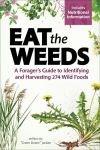

Eat the Weeds by “Green Deane” Jordan
$24.95
Florida’s Edible Wild Plants by Peggy Sias Lanz
$17.95
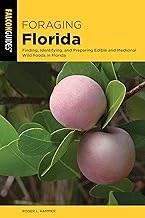
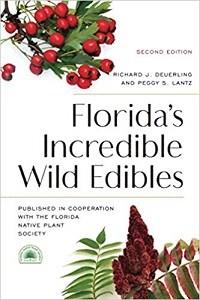
Foraging Florida by Roger L. Hammer
$24.95
Florida’s Incredible Wild Edibles by Richard J. Deuerling and Peggy S. Lantz
$9.95
Most of these (if not all) are also available on Amazon and other booksellers.

This recipe was submitted by Karen Harper. She uses it during the fall but with winter still in full effect who doesn’t like a bit of chocolate and cinnamon to ward off the winter blahs.
You can find the full recipe at CINfully Delicious Chocolate Cupcakes Recipe
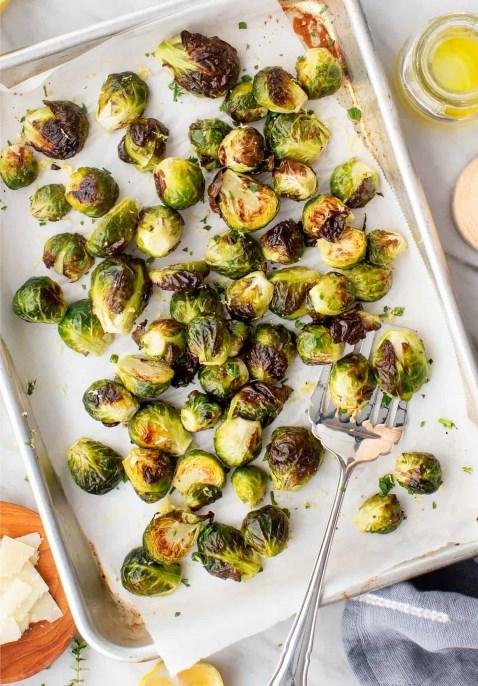
Another cozy recipe submitted by Marg Stewart. This time of year we can plant Brussel sprouts. Why not roast some up!
You can find the full recipe at Roasted Brussels Sprouts Recipe - Love and Lemons

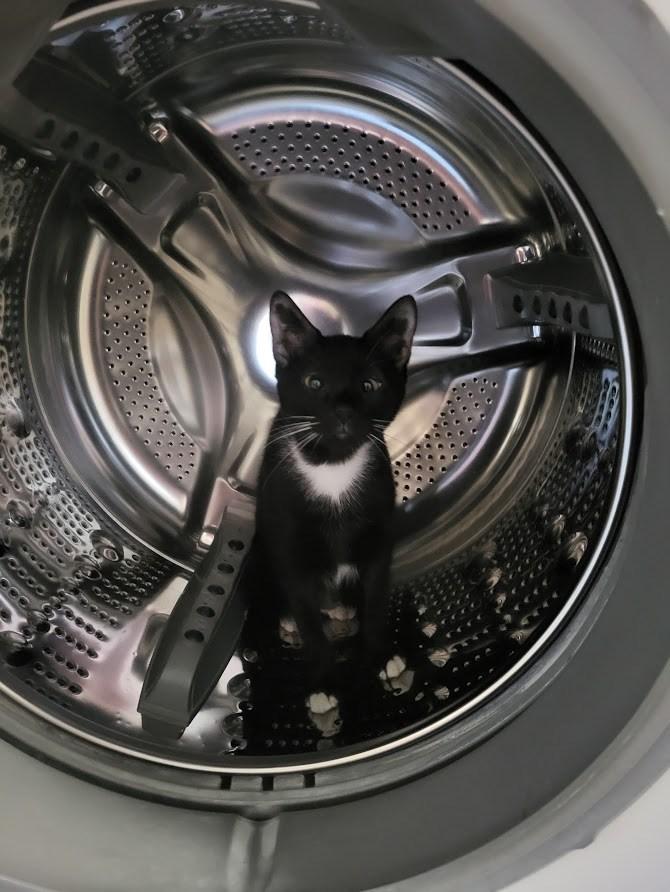
If you’ve ever had a cat you know that they love to investigate things. Yes, that is Luna(tic) in the washing machine. I had left the door open to dry out and that was obviously an invitation to inspect.
Be it a bag, box, wadded up towel, no matter the container it must be certified by the kitty inspector.
Another aspect is that she is the equivalent of a serious inspector since she will have laser focus for any new thing going on in her domain. Even if that means sitting on mom’ s chair in order to see better.
We really should take a lesson from Luna. No matter what it is, plant, insect, or other aspect of our gardening adventures; shouldn’t we thoroughly inspect it? Shouldn’t we take the deep dive and learn all we can about it? Who knows when that information will be helpful to us in the future. Not only that, we should always strive to be learning and investigating. The same attitude could be applied to pretty much every aspect of our lives especially with the immediate reporting on every little thing that happens (or doesn’t happen.) We need to stop, investigate, and come to our own conclusions based on the science.
it, something won’t be done as well if we do that. We should try to focus on the task at hand and only that. Turn off the phone or the computer and focus on what we need to do. How much time do we waste because we have to re-do something simply because we weren’t focused enough?
So one of my New Year resolutions is to focus and investigate everything.
From Luna(tic) and Eva(destruction) we wish you a very Happy New Year and all the best for the times to come.

Eva(destruction) the queen

Luna(tic) yes she is that cross-eyed
Laser focus is something else we need to practice. We all try to multi-task and quite honestly no matter how great we think we are at

PS
The laser focus was because mom was making a sandwich and she wanted to make sure all her favorites were in there.
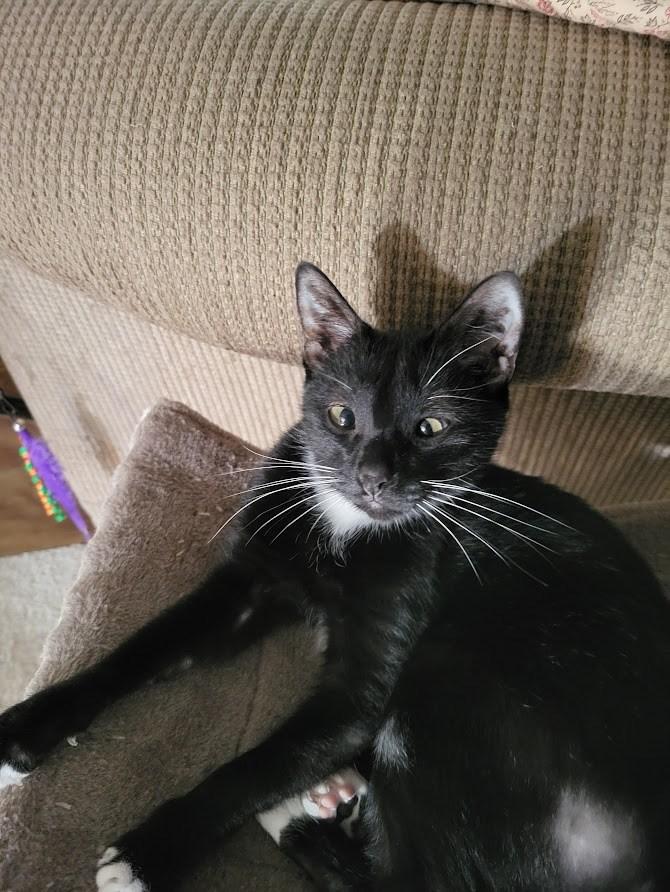

Equal Opportunity Institution
Mission
To assist Extension Agents in providing research-based horticultural education to Florida residents.
Vision
To be the most trusted resource for horticultural education in Florida.
The Compost Pile is a quarterly publication created by the Okaloosa County Master Gardener Volunteers.
Marg Stewart Editor
Karen Harper, Debbie Sewell, Katy McMackin Co-Editors

